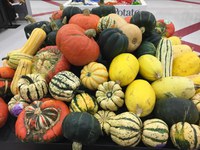Prairie Fare: All Eyes on Squash
(Click an image below to view a high-resolution image that can be downloaded)
By Julie Garden-Robinson, Food and Nutrition Specialist
NDSU Extension Service
“We live an exciting life,” my husband commented as he flipped a butternut squash on its side.
We were at a grocery store on a Saturday evening. An attractive display of colorful squash and pumpkins caught my eye, and I pulled my phone out of my purse to take a photo.
I stepped back to survey the appearance of the squash display. I began rearranging some squash because I didn’t want the price tags to show. I asked my husband to help. He was a good sport, although I think he was worried that we’d get in trouble for “tampering with a produce display.”
No squash were injured in my spur-of-the-moment photo shoot, by the way.
“I might be helping them sell more squash with my column,” I replied as I moved a buttercup squash to even out the colors. I walked back a few steps to frame my photo.
I think plant breeders had fun developing these interesting fruits for the market. I noted a “Carnival” squash looking festive with its splatters of cream and shades of green on an orange base. The “Sweet Dumpling” squash was smaller and cream-colored with dark green ridges.
The attractive “Turban” squash had a large “cap” (or turban) with orange, cream and green stripes. I noted the dark green acorn squash, which gets its name for obvious reasons. The creamy colored “Delicata” squash had fine green strips. If I cooked the pale yellow, elongated “Butternut” squash, it would have a pumpkinlike flavor.
I noticed some “Spaghetti” squash in the mix. This shiny yellow squash has flesh that splits into strands that resemble spaghetti.
A column idea had sparked in my brain. As I walked around the corner, I found another squash display. My husband looked at me sideways with raised eyebrows and a grin. I only moved one squash this time before I took another photo.
Although squash and pumpkins could be used as ornaments to decorate your table or front steps, make room for them on your plate. Squash are nutrition all-stars that are high in carotenoids, which are pigments that our body converts to vitamin A. This vitamin plays a role in eye, skin and mucous membrane health.
Squash are “in season” and they are a tasty and nutrient-rich addition to menus. Technically, squash typically is used in pumpkin pie filling. Sometimes, the ornamental “pumpkins” on display actually are squash.
Squash and pumpkin are part of the “Cucurbit” family, and they are “cousins” to zucchini and cucumbers. Even though squash is used as a vegetable on the menu, technically squash is the fruit of the plant.
If you have squash or pumpkins on vines in your garden, horticulture experts recommend you pick them before a hard freeze. Be sure to leave a few inches of the stem attached and allow them to “cure” a couple of weeks in a warm spot to toughen the skin and extend their storage life.
Squash can last many months if stored in a cool, dry place. If you happen to purchase cut squash, be sure to refrigerate it.
Squash can be prepared by cooking in water, baking or microwaving. To prepare squash in a conventional oven, simply rinse the squash thoroughly under cool water and scrub with a vegetable brush if needed. Poke several holes in the clean squash with a knife and place it in a pan. Bake without covering.
You can adjust the temperature and baking time depending on what else you might be baking. On average, a medium squash will take about an hour to bake at 350 F and would pair well with baked potatoes and meatloaf. If you are cooking something at 400 F, the squash will become tender sooner. When squash is fork-tender, you are ready to peel it, remove the seeds, mash and serve.
Although you might want to home-can some pumpkin, be aware that no safe canning guidelines for mashed pumpkin are available for home food preservers. However, you can freeze pumpkin. Visit https://www.ag.ndsu.edu/food and click on “Food Preservation,” then “Freezing Vegetables,” for advice on how to do it.
This novel recipe is courtesy of the Iowa State University “Spend Smart. Eat Smart.” program. The program team calculated the cost per serving at $1.08, so this is a nutritional bargain.
Butternut Squash Enchiladas
2 1/2 c. butternut squash (or other winter squash), cooked
1 (15-ounce) can black beans, drained and rinsed
1/2 c. onion, diced
1/2 c. fresh cilantro, chopped (or 3 Tbsp. dried cilantro/coriander)
2 tsp. garlic powder
1/2 tsp. cumin
1 c. shredded cheddar or Mexican blend cheese, divided
8 (6-inch) tortillas
1 c. salsa or 1 (10-ounce) can red or green enchilada sauce
1/2 c. Greek yogurt
Preheat oven to 375 F. Mix the squash, beans, onion, cilantro, garlic powder and cumin in a bowl. Mix 3/4 cup of the cheese into the squash mixture. Put a 1/2 cup strip of filling on each tortilla. Roll the tortilla around the filling. Put the tortilla into a greased 9- by 13-inch baking dish with the seam down. Cover the tortillas with the salsa or enchilada sauce. Put the rest of the cheese (1/4 cup) on the salsa. Bake for 25 minutes. Serve each enchilada with 1 tablespoon Greek yogurt.
Makes eight servings (one enchilada per serving). A serving has 220 calories, 3.5 grams (g) fat, 10 g protein, 35 g carbohydrate, 6 g fiber and 660 milligrams sodium.
(Julie Garden-Robinson, Ph.D., R.D., L.R.D., is a North Dakota State University Extension Service food and nutrition specialist and professor in the Department of Health, Nutrition and Exercise Sciences. Follow her on Twitter @jgardenrobinson)
NDSU Agriculture Communication - Oct. 5, 2017
| Source: | Julie Garden-Robinson, 701-231-7187, julie.garden-robinson@ndsu.edu |
|---|---|
| Editor: | Ellen Crawford, 701-231-5391, ellen.crawford@ndsu.edu |



